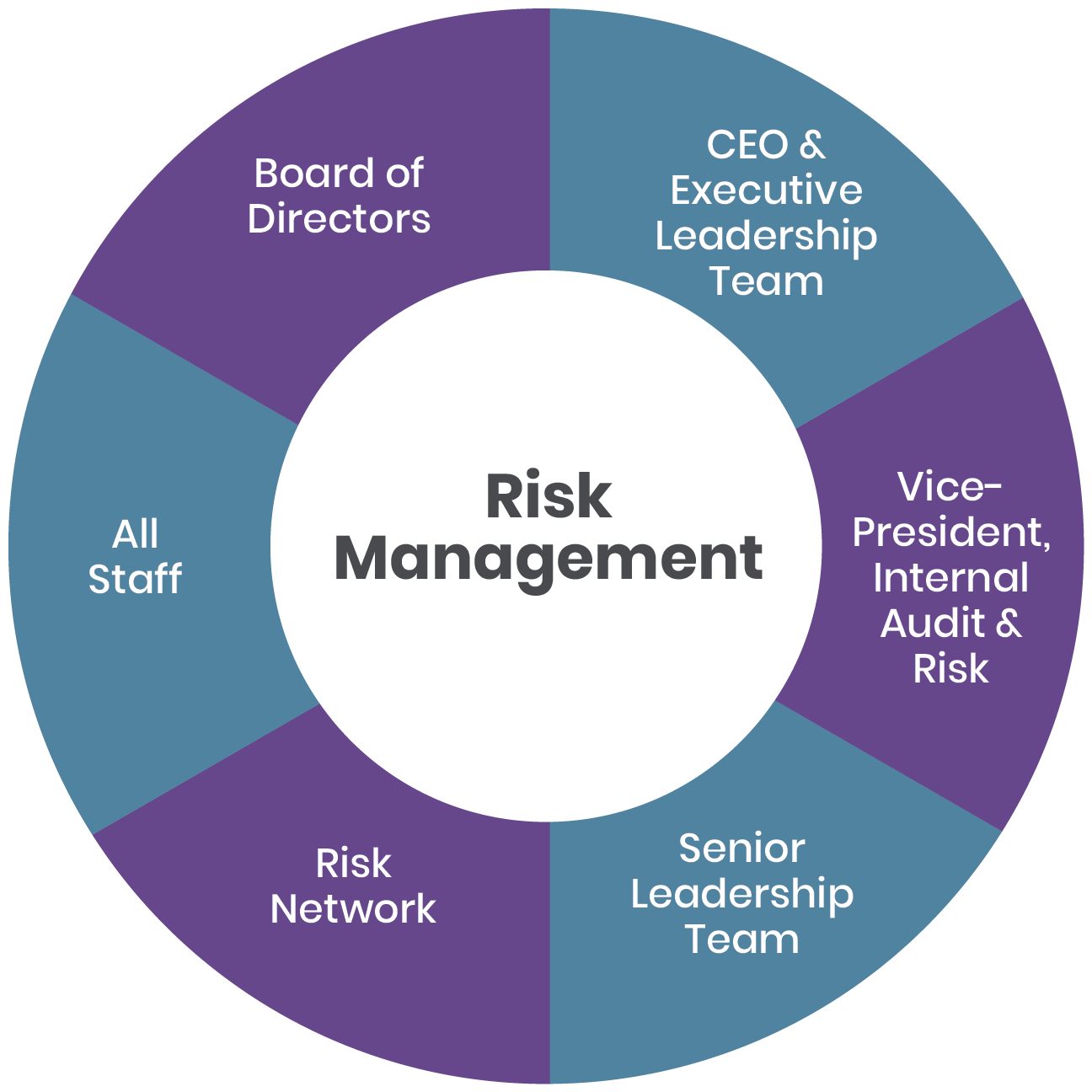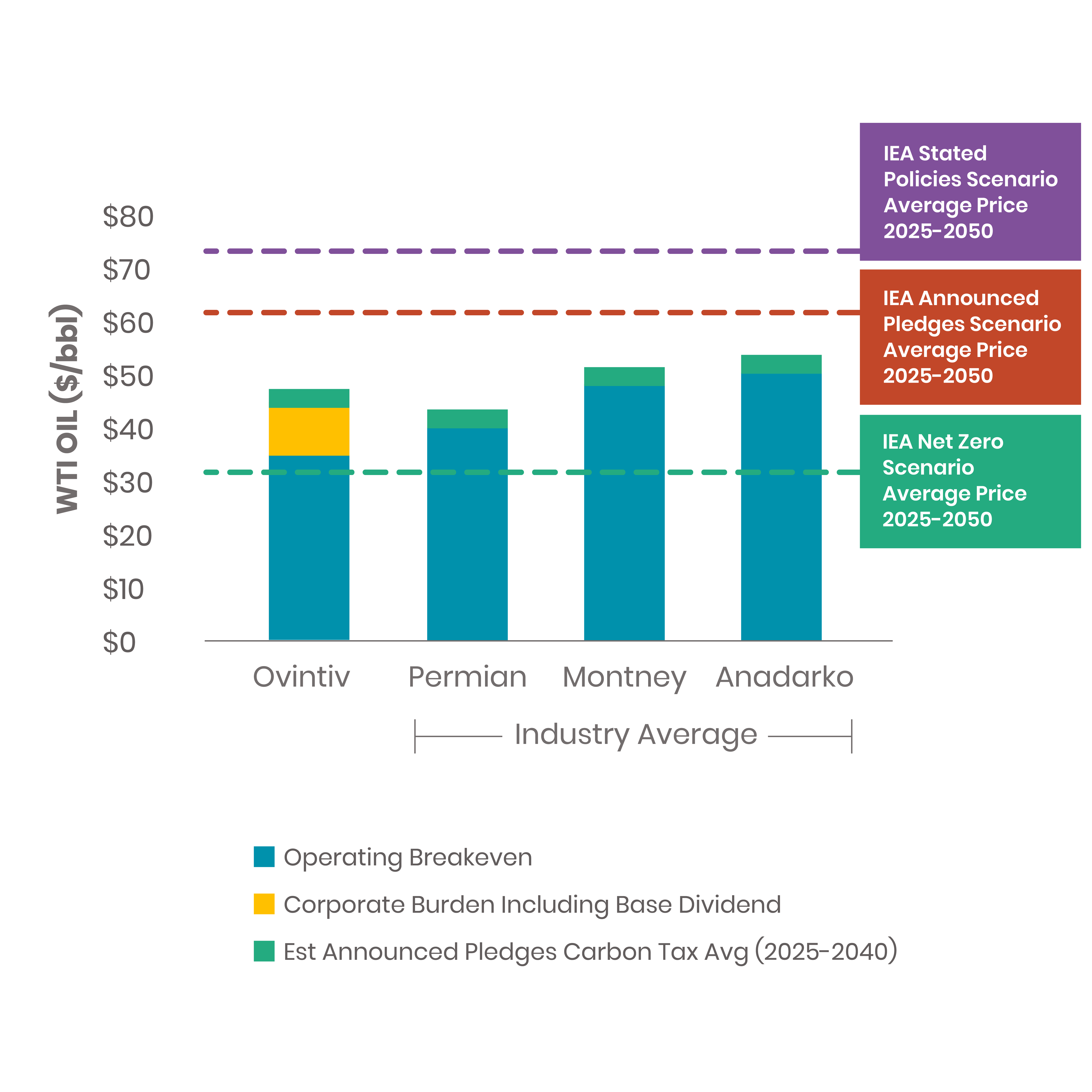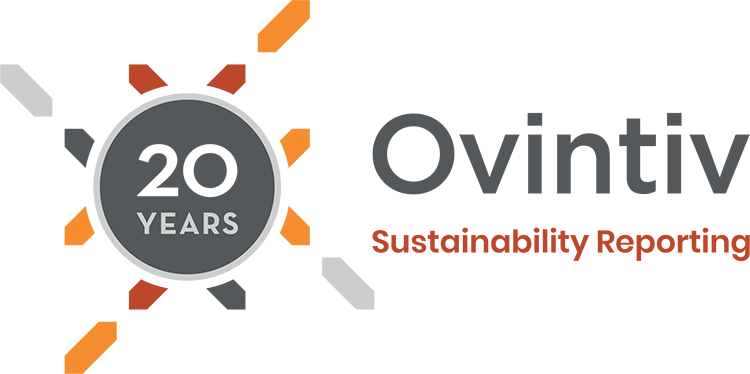RISK MANAGEMENT
Our Board is responsible for ensuring an effective risk management process is in place to identify, monitor and manage significant risks to our business and reputation.
Our risk management strategy includes identifying risks, and developing and implementing risk management practices that include mitigation activities, systems, controls and business continuity plans for specific risks, which are aligned with, and complementary to, our internal corporate risk management policy.
Our enterprise risk management process and our sustainability priority assessment help identify and monitor any significant risks. The identification, analysis and mitigation strategy of climate-related risk is incorporated into our risk practices and is a component of an internal Risk Network that comprises senior leadership responsible for understanding and reporting each of Ovintiv’s entity-level risks.
We use an internal risk matrix to form the foundation for assessing, measuring and reporting risks. It creates a consistent methodology to assess residual risks, which may exist after controls and mitigations have been put in place, measured in terms of probability and impact to achieving Ovintiv’s objectives.

Each level of our organization has defined roles and responsibilities outlined by our internal corporate risk management policy.
Potential Climate-Related Impacts to Our Business
Risks
We evaluate both physical risks and transition risks of climate change relating to regulatory, legal, reputational, technology, and market considerations, prioritize them for potential mitigation and incorporate them into risk factors or other disclosures as warranted.
Policy and Legal Risk
Policies governing climate-related issues are continuing to evolve in both the U.S. and Canada. As disclosed on page 40 of the Company’s 2024 Annual Report on Form 10-K, this includes actions that seek to address concerns over climate change, such as the enactment of climate-related regulations, policies and initiatives that seek to promote adaptation to climate change or lessen activities that contribute to the adverse effects of climate change.
Internationally, this has resulted in existing and pending international agreements to reduce GHG emissions globally, while in the U.S. and Canada, this has resulted in both national, regional and local legislation and regulatory programs.
Ovintiv actively participates in public policy development with federal, provincial, state and local levels in the U.S. and Canada to support effective policies governing responsible energy development in North America. We account for an escalation of our Canadian carbon tax costs in our planning and budgeting processes. We also run scenarios to determine how a U.S. implementation would impact our cost structures.
Market Risk
Shifts in supply and demand for certain commodities, including oil and natural gas (and associated products) due to concerns over climate change could affect markets. As identified on page 40 of the Company’s 2024 Annual Report on Form 10-K, lower demand for oil and natural gas or increased demand for lower-emission products and services could result in lower prices and lower revenues.
We use scenario planning to better predict the risks associated with future commodity prices. We utilize a range of prices that represent varying levels of supply and demand for our products. As a leading operator with more than a decade of high-quality drilling locations and a deep commitment to capital discipline, we are positioned to deliver competitive returns to our shareholders through our focus on execution, disciplined capital allocation, responsible operations, and leading capital efficiency.
Reputational Risk
Our 2024 Annual Report on Form 10-K (page 41) disclosed that public attention to issues concerning climate change continues to increase, with the oil and natural gas industry receiving heightened scrutiny regarding GHG emissions. These changing perceptions could lower demand for our oil and natural gas production, resulting in lower prices and lower revenues as consumers avoid carbon-intensive industries and could also pressure banks and investment managers to shift investments and reduce lending.
We monitor policy developments and engage with industry working groups and governments to provide input and advocate for policies supportive of emissions reductions initiatives. We participate in regular outreach programs with our investors and lenders and work to address their questions.
Technology Risk
The development and deployment of alternative energy sources and emerging technologies in renewable energy, battery storage and energy efficiency could lower demand for oil and natural gas and as stated in our 2024 Annual Report on Form 10-K (page 41), could potentially result in decreased revenues within the oil and natural gas industry and accelerate alternative energy technology.
We are continuously pursuing opportunities to collaborate on new emissions reduction technology and have established an Emissions Performance Group within the Chief Engineering Organization. This group works across disciplines within the Company to identify and evaluate operational emissions reduction opportunities, among other environmental improvements. We are also committed to understanding potential business opportunities that complement our vision and capitalize on our expertise.
Physical and Climate Risk
Adverse weather conditions such as severe heat or cold, flooding, tornados and other natural disasters could affect our operations. As identified on page 41 of our 2024 Annual Report on Form 10-K, if any such effects were to occur, they could adversely affect or delay demand for the oil or natural gas produced or cause us to incur significant costs in preparing for, or responding to, the effects of climatic events themselves.
The identification, analysis and mitigation strategy of climate-related risk is incorporated into our risk practices. We also have operational practices in place, including an emergency management incident response process that helps to manage risk associated with severe weather events. We continue to identify and pilot new technology, equipment and processes to manage through events. An example of this includes the development of an environmental hazard monitoring dashboard to track a variety of weather and geological events with potential to impact our operations.
Opportunities
We believe our corporate strategy and commitment to being a low-cost producer position us to successfully navigate both current and future climate-related risks.
We aim to be the leading North American oil and natural gas exploration and production Company by generating free cash flow and delivering superior returns both to our shareholders and on the capital we invest in our multi-basin, multi-product portfolio. By focusing on execution excellence, disciplined capital allocation, commercial acumen and risk management, our business can thrive across a variety of scenarios and deliver results in a socially and environmentally responsible manner.
Flexibility
Our development portfolio is centered on short-cycle opportunities, offering us the flexibility to adapt quickly at both the asset and portfolio level. This agility allows for rapid conversion of capital into cash flow and enables us to efficiently manage risks while seizing emerging opportunities.
Capital Discipline
In an evolving commodities market, we have continued our track record of demonstrating capital discipline while driving efficiency and lowering costs in every part of our business. As a leading North American operator, we will continue to strategically manage our supply chain and leverage technology and innovation to responsibly develop our assets.
Proven Experience
We have experience operating under carbon tax jurisdictions in Canada. Our corporate culture and structure fosters knowledge sharing, and we plan to apply the insights gained from our experience with carbon taxes to our U.S. assets should carbon tax regulations be introduced.
Innovation
Our culture of innovation drives us to adopt new technologies and operational efficiencies, particularly with the goal of enhancing free cash flow and reducing emissions intensity. Ovintiv closely follows technological advancements and will continue to deploy equipment proven to be effective in reducing emissions intensity.
Strategy
Ovintiv’s risk-informed business strategy incorporates key environment, social and governance considerations that could impact our performance. Our strategic planning and scenario analysis processes are ongoing, taking into account factors such as commodity prices, carbon taxes, regulations and the potential long-term impacts of climate change.
This process involves input from various stakeholders within the Company, as well as external advisors and commodity market analysis firms. Our strategic planning follows four interconnected and iterative workflows.
Macro Review
We conduct a macro analysis of both the business and industry environment, identifying key trends, risks and opportunities that could influence our corporate strategy.
Strategic Assessment
The findings from the macro review are incorporated into a strategic assessment, which tests the alignment of our current strategy and explores potential pathways for delivering long-term value to shareholders. This assessment is presented to, and discussed with, the executive leadership team annually.
Benchmark
Benchmarking is also incorporated in our strategic planning. We compare our strategic and competitive positioning against both industry peers and companies outside the exploration and production sector. This provides real-time intelligence and enhances our understanding of peer strategies, industry trends and business best practices.
Portfolio Evaluation
We conduct a comprehensive internal evaluation of our portfolio, identifying opportunities to enhance value through technological innovations, improved efficiency, reduced uncertainty, and resource optimization. During this phase, we develop and update asset development profiles, testing various scenarios and approaches to maximize long-term value creation.
Climate-Focused Scenario Analysis
We consider climate-related risks throughout our corporate strategic planning and scenario analysis process. Our scenario analysis leverages internal modeling, supported in part by the International Energy Agency’s (IEA) World Energy Outlook (WEO), to better understand the evolving global energy landscape.
We utilized three scenarios from the IEA’s 2024 Outlook, each of which contains assumptions regarding future population, economic growth and hydrocarbon supply and demand.
Stated Policies Scenario (STEPS): Reflects current policy settings that are in place and have been announced by governments around the world
Net Zero Emissions by 2050 Scenario (NZE): Outlines a pathway for the energy sector to achieve net zero carbon dioxide (CO2) emissions globally by 2050, in line with limiting the long-term global average temperature to 1.5 °C
By employing these scenarios, we can evaluate a range of potential risks related to commodity pricing and emissions reduction frameworks. Specifically, we test our current assets in our portfolio against potential future outcomes to identify challenges and opportunities. We also assess portfolio resiliency by comparing our assets’ performance under different IEA price forecasts, adjusted to the West Texas Intermediate (WTI) benchmark, against publicly available breakeven price assumptions per play. This analysis incorporates an escalating carbon tax in line with the IEA APS.
To demonstrate the current competitiveness of our portfolio, we included an Ovintiv Base Case Scenario. This scenario assumes holding crude and condensate scale at maintenance capital levels and is non-GAAP free cash flow positive after the base dividend.
Our analysis assumes a consistent breakeven price. Ovintiv has a strong track record of knowledge sharing, adopting innovative practices and driving efficiencies through our business. We expect this performance to continue, further reducing our breakeven prices and enhancing our portfolio resiliency and profitability.
In alignment with the SASB reporting recommendations, we tested our year-end 2024 reserves against the conditions outlined in the IEA STEPS and APS. The value of Ovintiv’s SEC 1P reserves comparing STEPS and the associated pricing and carbon tax to the SEC 12-month average trailing price forecast is ~30% higher on a NPV10 basis. Using the APS and its associated commodity pricing and carbon tax compared to the SEC price forecast resulted in the value of Ovintiv’s SEC 1P reserves decreasing ~1% on a NPV10 basis, driven by lower commodity pricing in the APS. However, the net present value of our future cash flows remained positive even under the APS scenario, and we believe that our multi-basin, diversified product portfolio is well positioned to be resilient in a low-carbon scenario.
Ovintiv is well positioned to continue to deliver safe, affordable, secure and reliable energy to the world
Our analysis confirms the expected resiliency of our portfolio across various potential future climate policy scenarios. Under both STEPS and APS scenarios, we anticipate new well development to continue to generate economic returns, as breakeven prices remain below forecast prices. Even with the implementation of an escalating carbon tax, our low-cost, short-cycle portfolio remains competitive.
In the hypothetical NZE 2050 scenario, it is crucial to consider cost and asset competitiveness, especially as tightening demand may lead to industry rationalization. The IEA has noted that the pathway to net zero emissions by 2050 is very narrow and relies on fair and effective global cooperation.

Significant Free Cash Flow Potential Across STEPS AND APS IEA Scenarios
